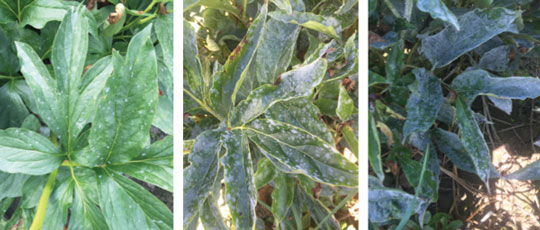7/31/2017
Imminent Mildews: It’s Powdery Mildew Season
Paul Pilon
While passing by some peonies, which recently finished blooming, the other day, I noticed powdery mildew had set in. This reminded me that several perennials are also highly susceptible to powdery mildew during the summer. Although, mildew can occur during any part of the growing season, many perennials—such as bee balm or garden phlox—are particularly susceptible to it as they’re beginning to flower or anytime thereafter.
Since we’re all in the industry, most of us are likely all too familiar with this disease. For those of you who sell plants, it unquestionably shows up at the worst time—just as certain perennials are beginning to bloom and reach their peak marketability. For those who simply enjoy them in the landscape, there’s a glimmer of good news: powdery mildew usually doesn’t kill the plants. However, it does dramatically decrease their aesthetic appeal during the current growing
season.
Being we’re at the onset of another imminent season for powdery mildew, I thought I’d share some of my thoughts and management strategies.
What to look for
Powdery mildew can be somewhat difficult to detect. The first colonies usually develop on the lower half of the plant where there’s less air movement. Look for small ¼- to ½-in. (6- to 13-mm) diameter whitish-gray talcum-like powdery patches. They can often be mistaken for spray residue, so look more closely if sprays have recently been applied. When conditions are favorable, these patches quickly coalesce and can completely cover the leaves or the entire above-ground portions of the plant.
In some instances, powdery mildew causes the leaves of infected plants to develop purplish blotches or edges without any white colonization on the leaf surfaces. Therefore, powdery mildew infections occasionally get mistaken for nutrient deficiencies. There are a few plants, such as sedum, which develop brown scab-like spots with very little, if any, of the white powdery growth present. Powdery mildew is often mistaken for other pathogens or disorders when it expresses these symptoms.
Pictured: Here are three stages of infection on garden peonies. Left to right: Slight infection–just beginning, moderate infection and heavy infection.

When does powdery mildew develop?
High relative humidity (greater than 70%), particularly at night, is the main criteria for powdery mildew infections to develop. Unlike most pathogens, it doesn’t require free moisture on the leaf surfaces to infect the plant. Powdery mildew infections occur with temperatures between 62 and 86F (16 to 30C) and develops fastest between 70 to 80F (21 to 27C). Once a plant has been infected, the relative humidity is no longer a factor and the pathogen can continue its life cycle regardless of the humidity.
Can powdery mildew be prevented?
Powdery mildew can be prevented if high humidity levels could be avoided. This is easier said than done. However, growing plants at wide spacings will reduce the humidity levels around the plants. When plants are within enclosed structures, increase the air circulation around the plants using horizontal air flow fans and ventilate the houses regularly to keep the humidity levels low.
What can be done once powdery mildew is detected?
Monitor susceptible crops at least once each week. Early detection and promptly implementing control strategies is highly effective at keeping powdery mildew at bay and maintaining highly marketable perennials. If you have a history of experiencing powdery mildew or are growing highly susceptible crops, a preventative fungicide program can be implemented.
Biorational compounds—including those containing bacillus subtilis, hydrogen peroxide, neem oil, horticultural oil, insecticidal soap or potassium bicarbonate—can be quite effective when used preventatively or when applied upon early detection. The best control using these products is obtained when multiple applications with complete coverage of the foliage are made.
Fungicides containing the active ingredients azoxystrobin, copper sulphate pentahydrate, myclobutanil, piperalin, pyraclostrobin, triadimefon and triflumizole provide very good control of powdery mildew. In many instances, adding a non-ionic surfactant with some of these fungicides will improve the efficacy of these applications. (Refer to each fungicide’s label for regarding the use of surfactants.) Multiple applications may be necessary to obtain complete control of these pathogens. Remember to rotate fungicides using different modes of action to prevent powdery mildew from developing resistance to these products.
The mention of specific active ingredients doesn’t constitute an endorsement or recommendation of or discrimination against similar products not mentioned.
Always read product labels and use them as directed.
GT
Paul Pilon is a Perennial Production Consultant and editor-at-large of the Perennial Pulse
e-newsletter. Feel free to contact him with article topics or to address your perennial production challenges. He can be reached at paul@perennialsolutions.com.